Business Report: Analysis of Hilton's Digital Marketing Project
VerifiedAdded on 2022/12/22
|12
|3249
|69
Report
AI Summary
This report analyzes a work-based learning project centered on Hilton's digital marketing campaign. The project involved the development and implementation of a loyalty program app, aiming to enhance market share and revenue. The report details the project lifecycle, including initiation, planning, implementation, and closure phases. It also discusses the setting of aims and objectives, along with the application of SWOT, PESTLE, and Porter's five forces analyses to evaluate the project's strengths, weaknesses, opportunities, threats, and the external factors influencing its success. The report highlights the campaign's focus on improving customer experience and leveraging digital platforms for marketing. The report also includes a brief description of the project's objectives, aimed at increasing market share and revenue through the HHonors loyalty program and a complementary app. The report also emphasizes the use of different analysis tools, such as SWOT, PESTLE, and Porter's five forces, to analyze the project's external environment and internal capabilities. The report concludes with a reflection on the overall experience and learning gained during the project, providing a comprehensive overview of the project's planning, execution, and evaluation.
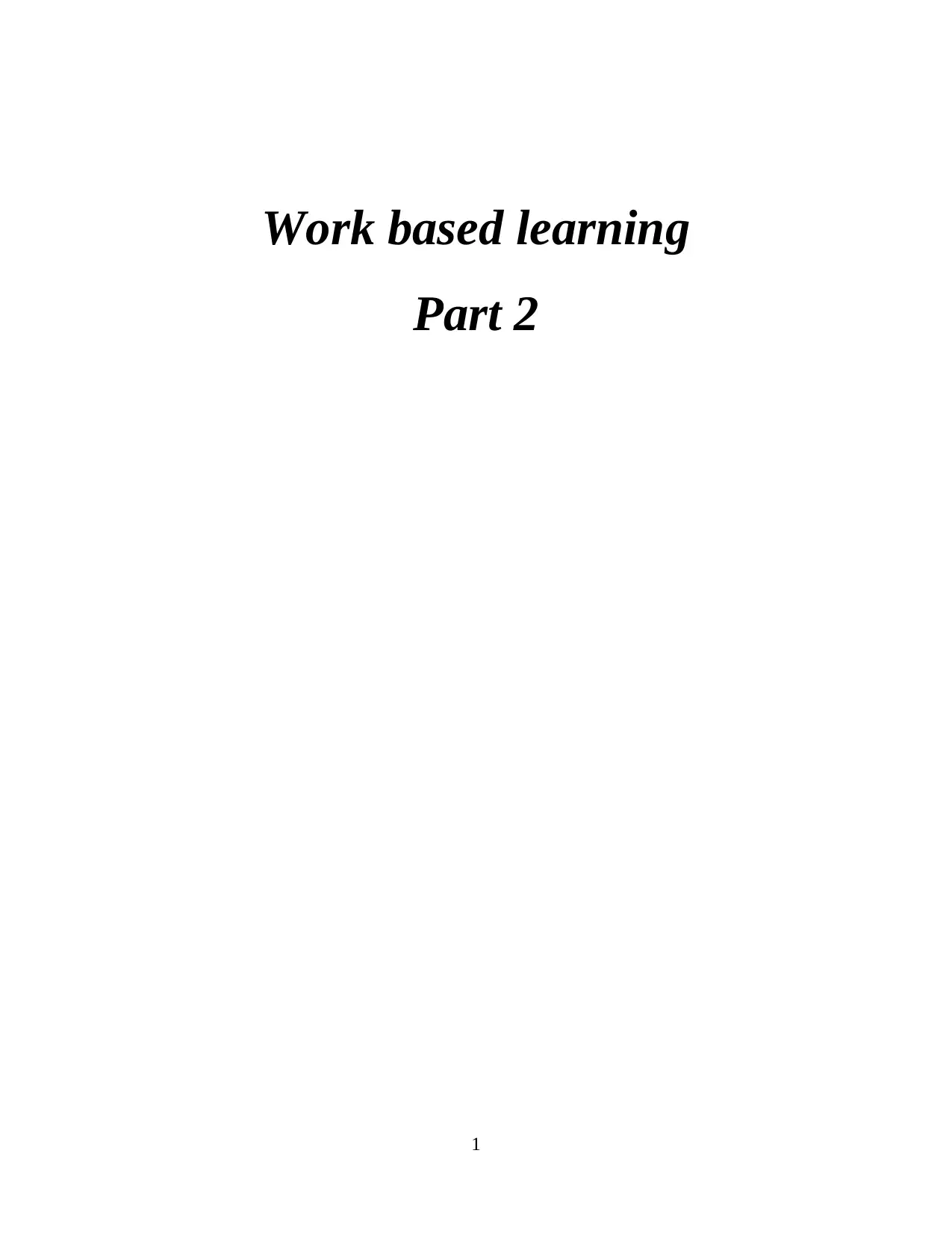
Work based learning
Part 2
1
Part 2
1
Paraphrase This Document
Need a fresh take? Get an instant paraphrase of this document with our AI Paraphraser

Table of Contents
Introduction......................................................................................................................................3
Aims, objectives.....................................................................................................................3
Project lifecycle......................................................................................................................3
Benefits of set aims and objectives:.......................................................................................5
Application of SWOT, PESTLE and Porters five forces.......................................................5
Conclusion.....................................................................................................................................10
REFERENCES..............................................................................................................................11
2
Introduction......................................................................................................................................3
Aims, objectives.....................................................................................................................3
Project lifecycle......................................................................................................................3
Benefits of set aims and objectives:.......................................................................................5
Application of SWOT, PESTLE and Porters five forces.......................................................5
Conclusion.....................................................................................................................................10
REFERENCES..............................................................................................................................11
2
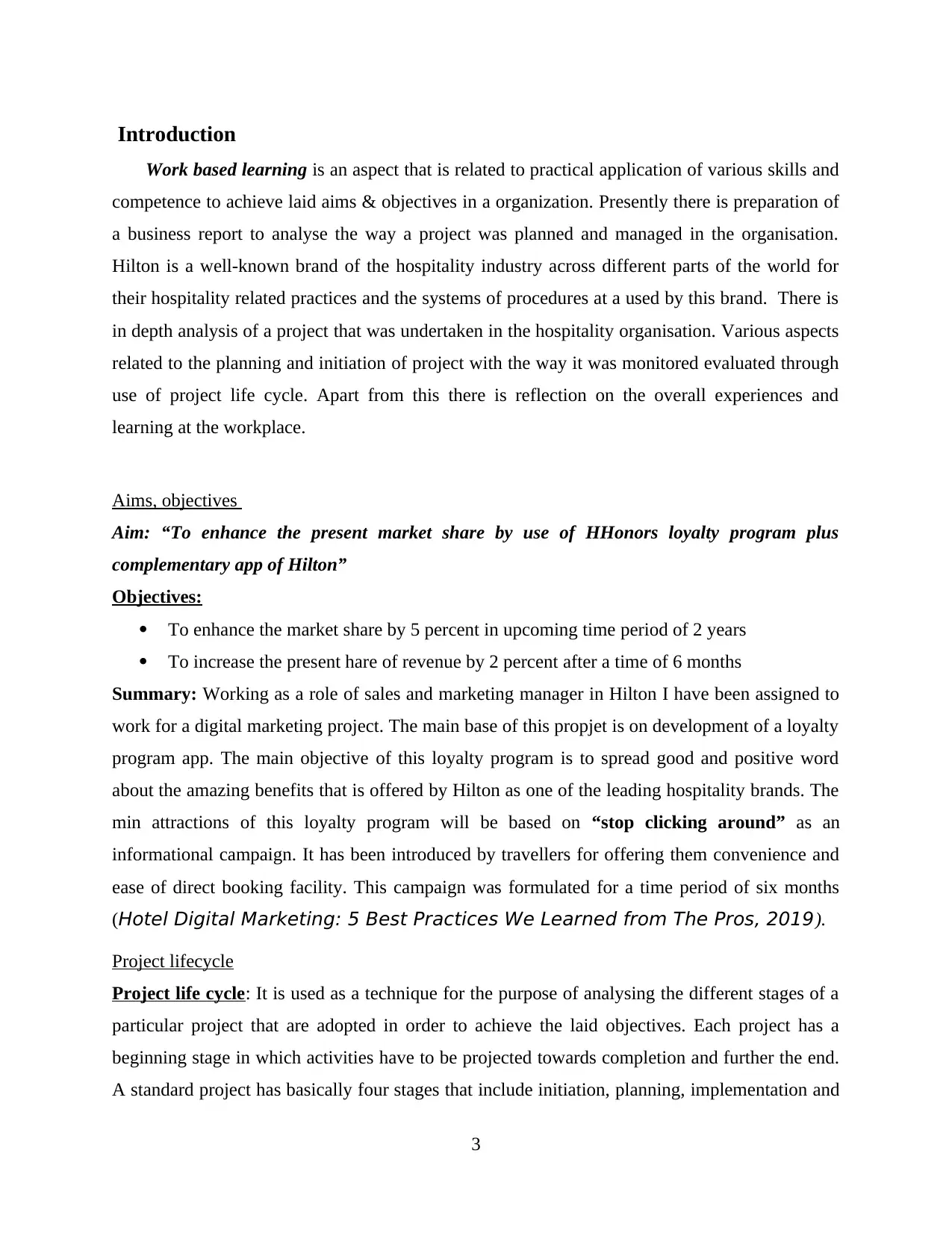
Introduction
Work based learning is an aspect that is related to practical application of various skills and
competence to achieve laid aims & objectives in a organization. Presently there is preparation of
a business report to analyse the way a project was planned and managed in the organisation.
Hilton is a well-known brand of the hospitality industry across different parts of the world for
their hospitality related practices and the systems of procedures at a used by this brand. There is
in depth analysis of a project that was undertaken in the hospitality organisation. Various aspects
related to the planning and initiation of project with the way it was monitored evaluated through
use of project life cycle. Apart from this there is reflection on the overall experiences and
learning at the workplace.
Aims, objectives
Aim: “To enhance the present market share by use of HHonors loyalty program plus
complementary app of Hilton”
Objectives:
To enhance the market share by 5 percent in upcoming time period of 2 years
To increase the present hare of revenue by 2 percent after a time of 6 months
Summary: Working as a role of sales and marketing manager in Hilton I have been assigned to
work for a digital marketing project. The main base of this propjet is on development of a loyalty
program app. The main objective of this loyalty program is to spread good and positive word
about the amazing benefits that is offered by Hilton as one of the leading hospitality brands. The
min attractions of this loyalty program will be based on “stop clicking around” as an
informational campaign. It has been introduced by travellers for offering them convenience and
ease of direct booking facility. This campaign was formulated for a time period of six months
(Hotel Digital Marketing: 5 Best Practices We Learned from The Pros, 2019).
Project lifecycle
Project life cycle: It is used as a technique for the purpose of analysing the different stages of a
particular project that are adopted in order to achieve the laid objectives. Each project has a
beginning stage in which activities have to be projected towards completion and further the end.
A standard project has basically four stages that include initiation, planning, implementation and
3
Work based learning is an aspect that is related to practical application of various skills and
competence to achieve laid aims & objectives in a organization. Presently there is preparation of
a business report to analyse the way a project was planned and managed in the organisation.
Hilton is a well-known brand of the hospitality industry across different parts of the world for
their hospitality related practices and the systems of procedures at a used by this brand. There is
in depth analysis of a project that was undertaken in the hospitality organisation. Various aspects
related to the planning and initiation of project with the way it was monitored evaluated through
use of project life cycle. Apart from this there is reflection on the overall experiences and
learning at the workplace.
Aims, objectives
Aim: “To enhance the present market share by use of HHonors loyalty program plus
complementary app of Hilton”
Objectives:
To enhance the market share by 5 percent in upcoming time period of 2 years
To increase the present hare of revenue by 2 percent after a time of 6 months
Summary: Working as a role of sales and marketing manager in Hilton I have been assigned to
work for a digital marketing project. The main base of this propjet is on development of a loyalty
program app. The main objective of this loyalty program is to spread good and positive word
about the amazing benefits that is offered by Hilton as one of the leading hospitality brands. The
min attractions of this loyalty program will be based on “stop clicking around” as an
informational campaign. It has been introduced by travellers for offering them convenience and
ease of direct booking facility. This campaign was formulated for a time period of six months
(Hotel Digital Marketing: 5 Best Practices We Learned from The Pros, 2019).
Project lifecycle
Project life cycle: It is used as a technique for the purpose of analysing the different stages of a
particular project that are adopted in order to achieve the laid objectives. Each project has a
beginning stage in which activities have to be projected towards completion and further the end.
A standard project has basically four stages that include initiation, planning, implementation and
3
⊘ This is a preview!⊘
Do you want full access?
Subscribe today to unlock all pages.

Trusted by 1+ million students worldwide
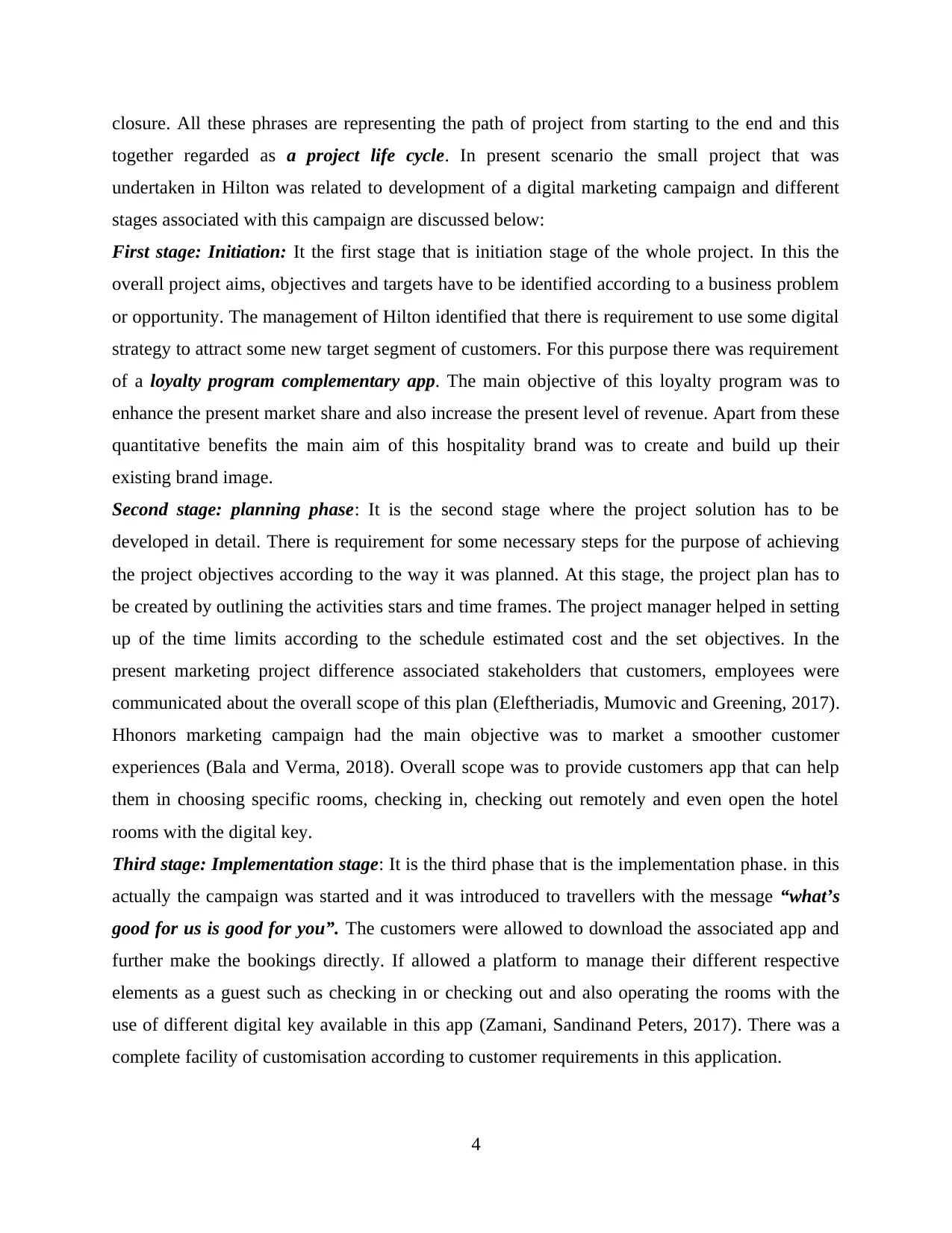
closure. All these phrases are representing the path of project from starting to the end and this
together regarded as a project life cycle. In present scenario the small project that was
undertaken in Hilton was related to development of a digital marketing campaign and different
stages associated with this campaign are discussed below:
First stage: Initiation: It the first stage that is initiation stage of the whole project. In this the
overall project aims, objectives and targets have to be identified according to a business problem
or opportunity. The management of Hilton identified that there is requirement to use some digital
strategy to attract some new target segment of customers. For this purpose there was requirement
of a loyalty program complementary app. The main objective of this loyalty program was to
enhance the present market share and also increase the present level of revenue. Apart from these
quantitative benefits the main aim of this hospitality brand was to create and build up their
existing brand image.
Second stage: planning phase: It is the second stage where the project solution has to be
developed in detail. There is requirement for some necessary steps for the purpose of achieving
the project objectives according to the way it was planned. At this stage, the project plan has to
be created by outlining the activities stars and time frames. The project manager helped in setting
up of the time limits according to the schedule estimated cost and the set objectives. In the
present marketing project difference associated stakeholders that customers, employees were
communicated about the overall scope of this plan (Eleftheriadis, Mumovic and Greening, 2017).
Hhonors marketing campaign had the main objective was to market a smoother customer
experiences (Bala and Verma, 2018). Overall scope was to provide customers app that can help
them in choosing specific rooms, checking in, checking out remotely and even open the hotel
rooms with the digital key.
Third stage: Implementation stage: It is the third phase that is the implementation phase. in this
actually the campaign was started and it was introduced to travellers with the message “what’s
good for us is good for you”. The customers were allowed to download the associated app and
further make the bookings directly. If allowed a platform to manage their different respective
elements as a guest such as checking in or checking out and also operating the rooms with the
use of different digital key available in this app (Zamani, Sandinand Peters, 2017). There was a
complete facility of customisation according to customer requirements in this application.
4
together regarded as a project life cycle. In present scenario the small project that was
undertaken in Hilton was related to development of a digital marketing campaign and different
stages associated with this campaign are discussed below:
First stage: Initiation: It the first stage that is initiation stage of the whole project. In this the
overall project aims, objectives and targets have to be identified according to a business problem
or opportunity. The management of Hilton identified that there is requirement to use some digital
strategy to attract some new target segment of customers. For this purpose there was requirement
of a loyalty program complementary app. The main objective of this loyalty program was to
enhance the present market share and also increase the present level of revenue. Apart from these
quantitative benefits the main aim of this hospitality brand was to create and build up their
existing brand image.
Second stage: planning phase: It is the second stage where the project solution has to be
developed in detail. There is requirement for some necessary steps for the purpose of achieving
the project objectives according to the way it was planned. At this stage, the project plan has to
be created by outlining the activities stars and time frames. The project manager helped in setting
up of the time limits according to the schedule estimated cost and the set objectives. In the
present marketing project difference associated stakeholders that customers, employees were
communicated about the overall scope of this plan (Eleftheriadis, Mumovic and Greening, 2017).
Hhonors marketing campaign had the main objective was to market a smoother customer
experiences (Bala and Verma, 2018). Overall scope was to provide customers app that can help
them in choosing specific rooms, checking in, checking out remotely and even open the hotel
rooms with the digital key.
Third stage: Implementation stage: It is the third phase that is the implementation phase. in this
actually the campaign was started and it was introduced to travellers with the message “what’s
good for us is good for you”. The customers were allowed to download the associated app and
further make the bookings directly. If allowed a platform to manage their different respective
elements as a guest such as checking in or checking out and also operating the rooms with the
use of different digital key available in this app (Zamani, Sandinand Peters, 2017). There was a
complete facility of customisation according to customer requirements in this application.
4
Paraphrase This Document
Need a fresh take? Get an instant paraphrase of this document with our AI Paraphraser
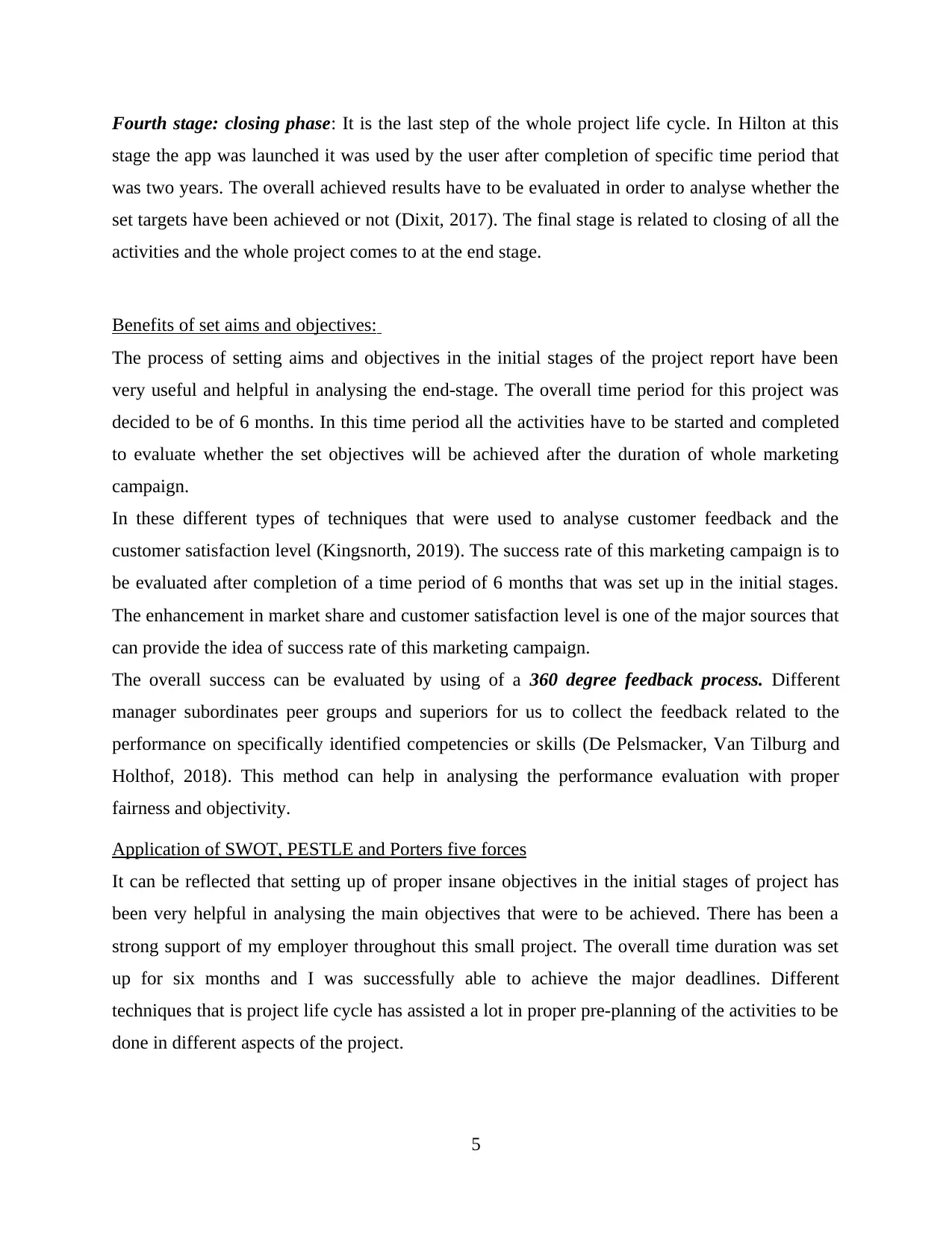
Fourth stage: closing phase: It is the last step of the whole project life cycle. In Hilton at this
stage the app was launched it was used by the user after completion of specific time period that
was two years. The overall achieved results have to be evaluated in order to analyse whether the
set targets have been achieved or not (Dixit, 2017). The final stage is related to closing of all the
activities and the whole project comes to at the end stage.
Benefits of set aims and objectives:
The process of setting aims and objectives in the initial stages of the project report have been
very useful and helpful in analysing the end-stage. The overall time period for this project was
decided to be of 6 months. In this time period all the activities have to be started and completed
to evaluate whether the set objectives will be achieved after the duration of whole marketing
campaign.
In these different types of techniques that were used to analyse customer feedback and the
customer satisfaction level (Kingsnorth, 2019). The success rate of this marketing campaign is to
be evaluated after completion of a time period of 6 months that was set up in the initial stages.
The enhancement in market share and customer satisfaction level is one of the major sources that
can provide the idea of success rate of this marketing campaign.
The overall success can be evaluated by using of a 360 degree feedback process. Different
manager subordinates peer groups and superiors for us to collect the feedback related to the
performance on specifically identified competencies or skills (De Pelsmacker, Van Tilburg and
Holthof, 2018). This method can help in analysing the performance evaluation with proper
fairness and objectivity.
Application of SWOT, PESTLE and Porters five forces
It can be reflected that setting up of proper insane objectives in the initial stages of project has
been very helpful in analysing the main objectives that were to be achieved. There has been a
strong support of my employer throughout this small project. The overall time duration was set
up for six months and I was successfully able to achieve the major deadlines. Different
techniques that is project life cycle has assisted a lot in proper pre-planning of the activities to be
done in different aspects of the project.
5
stage the app was launched it was used by the user after completion of specific time period that
was two years. The overall achieved results have to be evaluated in order to analyse whether the
set targets have been achieved or not (Dixit, 2017). The final stage is related to closing of all the
activities and the whole project comes to at the end stage.
Benefits of set aims and objectives:
The process of setting aims and objectives in the initial stages of the project report have been
very useful and helpful in analysing the end-stage. The overall time period for this project was
decided to be of 6 months. In this time period all the activities have to be started and completed
to evaluate whether the set objectives will be achieved after the duration of whole marketing
campaign.
In these different types of techniques that were used to analyse customer feedback and the
customer satisfaction level (Kingsnorth, 2019). The success rate of this marketing campaign is to
be evaluated after completion of a time period of 6 months that was set up in the initial stages.
The enhancement in market share and customer satisfaction level is one of the major sources that
can provide the idea of success rate of this marketing campaign.
The overall success can be evaluated by using of a 360 degree feedback process. Different
manager subordinates peer groups and superiors for us to collect the feedback related to the
performance on specifically identified competencies or skills (De Pelsmacker, Van Tilburg and
Holthof, 2018). This method can help in analysing the performance evaluation with proper
fairness and objectivity.
Application of SWOT, PESTLE and Porters five forces
It can be reflected that setting up of proper insane objectives in the initial stages of project has
been very helpful in analysing the main objectives that were to be achieved. There has been a
strong support of my employer throughout this small project. The overall time duration was set
up for six months and I was successfully able to achieve the major deadlines. Different
techniques that is project life cycle has assisted a lot in proper pre-planning of the activities to be
done in different aspects of the project.
5
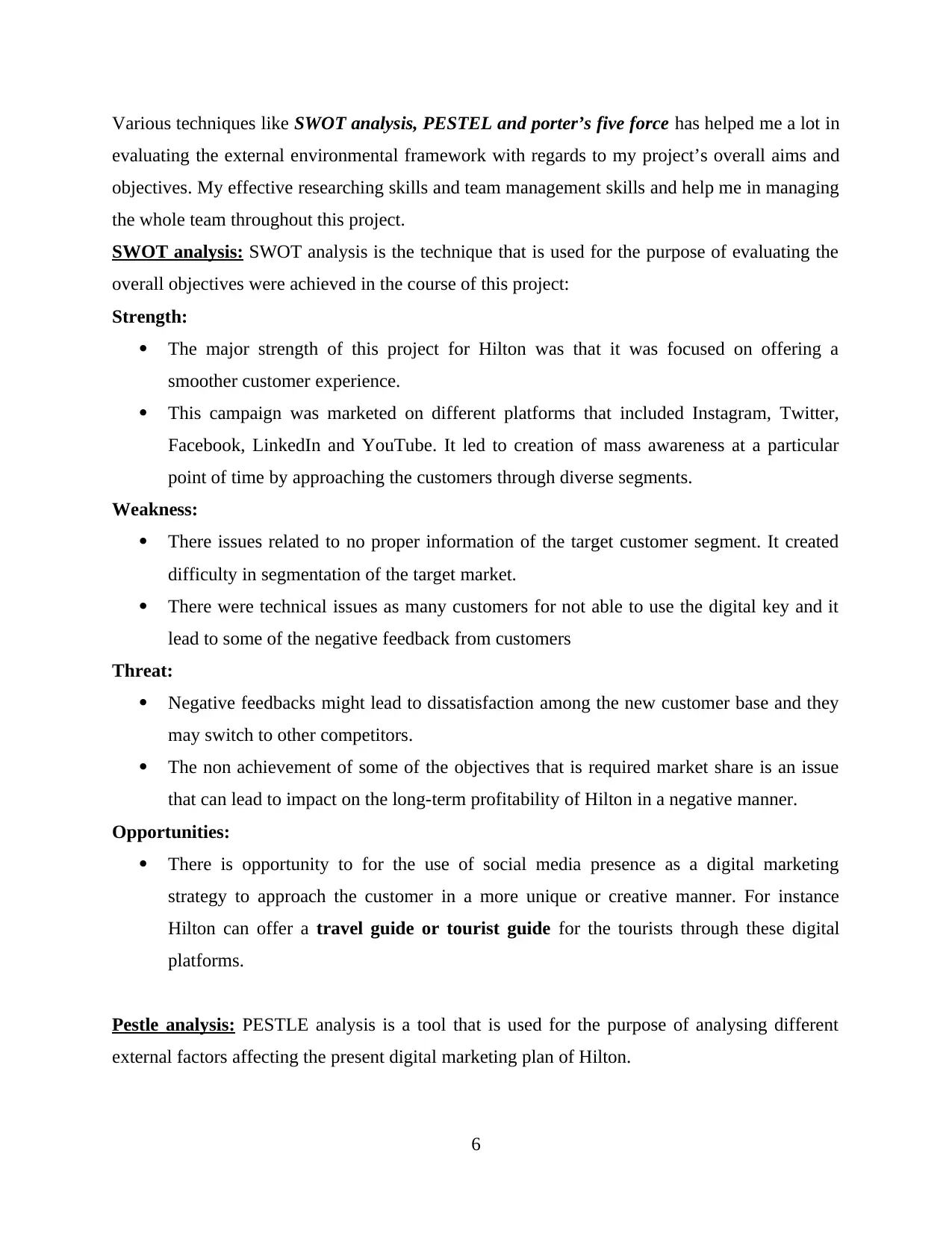
Various techniques like SWOT analysis, PESTEL and porter’s five force has helped me a lot in
evaluating the external environmental framework with regards to my project’s overall aims and
objectives. My effective researching skills and team management skills and help me in managing
the whole team throughout this project.
SWOT analysis: SWOT analysis is the technique that is used for the purpose of evaluating the
overall objectives were achieved in the course of this project:
Strength:
The major strength of this project for Hilton was that it was focused on offering a
smoother customer experience.
This campaign was marketed on different platforms that included Instagram, Twitter,
Facebook, LinkedIn and YouTube. It led to creation of mass awareness at a particular
point of time by approaching the customers through diverse segments.
Weakness:
There issues related to no proper information of the target customer segment. It created
difficulty in segmentation of the target market.
There were technical issues as many customers for not able to use the digital key and it
lead to some of the negative feedback from customers
Threat:
Negative feedbacks might lead to dissatisfaction among the new customer base and they
may switch to other competitors.
The non achievement of some of the objectives that is required market share is an issue
that can lead to impact on the long-term profitability of Hilton in a negative manner.
Opportunities:
There is opportunity to for the use of social media presence as a digital marketing
strategy to approach the customer in a more unique or creative manner. For instance
Hilton can offer a travel guide or tourist guide for the tourists through these digital
platforms.
Pestle analysis: PESTLE analysis is a tool that is used for the purpose of analysing different
external factors affecting the present digital marketing plan of Hilton.
6
evaluating the external environmental framework with regards to my project’s overall aims and
objectives. My effective researching skills and team management skills and help me in managing
the whole team throughout this project.
SWOT analysis: SWOT analysis is the technique that is used for the purpose of evaluating the
overall objectives were achieved in the course of this project:
Strength:
The major strength of this project for Hilton was that it was focused on offering a
smoother customer experience.
This campaign was marketed on different platforms that included Instagram, Twitter,
Facebook, LinkedIn and YouTube. It led to creation of mass awareness at a particular
point of time by approaching the customers through diverse segments.
Weakness:
There issues related to no proper information of the target customer segment. It created
difficulty in segmentation of the target market.
There were technical issues as many customers for not able to use the digital key and it
lead to some of the negative feedback from customers
Threat:
Negative feedbacks might lead to dissatisfaction among the new customer base and they
may switch to other competitors.
The non achievement of some of the objectives that is required market share is an issue
that can lead to impact on the long-term profitability of Hilton in a negative manner.
Opportunities:
There is opportunity to for the use of social media presence as a digital marketing
strategy to approach the customer in a more unique or creative manner. For instance
Hilton can offer a travel guide or tourist guide for the tourists through these digital
platforms.
Pestle analysis: PESTLE analysis is a tool that is used for the purpose of analysing different
external factors affecting the present digital marketing plan of Hilton.
6
⊘ This is a preview!⊘
Do you want full access?
Subscribe today to unlock all pages.

Trusted by 1+ million students worldwide

Political factors: The present political scenario of United Kingdom that is British exiting from
the European Union has created a lot of uncertainty. It is one of the political factors that are
affecting the different industries in different manner and hospitality industry is going to be
affected by this factor in long run. There is high amount of uncertainty in the coming future time
period (PESTLE Analysis of UK, 2020).
Economic factors: The present GDP runs in United Kingdom has been positioning it on 6th
number across world. The present inflation in UK is also at 1.94 % and it was approx 1.7 % in
the year 2019. It has grown by approximately 3.1 % since year 2017. According to financial
analysts the increment rate in inflation is now not going to increase anytime soon in coming
future. It is going to offer hospitality industry on opportunity to expand their market share by use
of digital campaigns. Unemployment rate across United Kingdom has been at approximately 3.8
%. The per capita income of this country is higher that is related to contributing one's share in
economy. So as per this analysis it can be summarised that the economic factors are in favour of
hospitality industry. Hilton has a opportunity to expand its market share through launching of
short term campaigns with limited investments (PESTLE Analysis of UK, 2020).
Legal factors: There are some of the specific legal laws that are to be compulsorily followed in
Hilton. While launching a digital marketing campaign they have two other two laws of minimum
wage maternity leaves holiday pay. Equality act 2010 has also to be followed so that each
employee is offered equal opportunity and there is no prevalence of discrimination based on
gender calories or such other type (Vitale and et. al 2017). It is going to help employees being
legally protected and not facing any type of discrimination.
Social factors: The social preference of people is shifting towards a more digital approach. In the
ever expanding digital connectivity health and will offer a digital marketing platform for their
travellers. This is going to assist them in having proper association with the brand through such
applications. The stop clicking around campaign will help in introducing the travellers with
convenience and ease of direct booking.
Technology factors: The use of social media applications in case of present digital marketing
plan of Hilton is going to help in having a technological advantage. There is a shift towards
growing use of internet and it has lead to or technological shift from traditional bookings to to
online booking by customers (Chaffey and Ellis-Chadwick, ., 2019). It offers a benefit for Hilton
as they are adapting according to the changing technological needs of customers.
7
the European Union has created a lot of uncertainty. It is one of the political factors that are
affecting the different industries in different manner and hospitality industry is going to be
affected by this factor in long run. There is high amount of uncertainty in the coming future time
period (PESTLE Analysis of UK, 2020).
Economic factors: The present GDP runs in United Kingdom has been positioning it on 6th
number across world. The present inflation in UK is also at 1.94 % and it was approx 1.7 % in
the year 2019. It has grown by approximately 3.1 % since year 2017. According to financial
analysts the increment rate in inflation is now not going to increase anytime soon in coming
future. It is going to offer hospitality industry on opportunity to expand their market share by use
of digital campaigns. Unemployment rate across United Kingdom has been at approximately 3.8
%. The per capita income of this country is higher that is related to contributing one's share in
economy. So as per this analysis it can be summarised that the economic factors are in favour of
hospitality industry. Hilton has a opportunity to expand its market share through launching of
short term campaigns with limited investments (PESTLE Analysis of UK, 2020).
Legal factors: There are some of the specific legal laws that are to be compulsorily followed in
Hilton. While launching a digital marketing campaign they have two other two laws of minimum
wage maternity leaves holiday pay. Equality act 2010 has also to be followed so that each
employee is offered equal opportunity and there is no prevalence of discrimination based on
gender calories or such other type (Vitale and et. al 2017). It is going to help employees being
legally protected and not facing any type of discrimination.
Social factors: The social preference of people is shifting towards a more digital approach. In the
ever expanding digital connectivity health and will offer a digital marketing platform for their
travellers. This is going to assist them in having proper association with the brand through such
applications. The stop clicking around campaign will help in introducing the travellers with
convenience and ease of direct booking.
Technology factors: The use of social media applications in case of present digital marketing
plan of Hilton is going to help in having a technological advantage. There is a shift towards
growing use of internet and it has lead to or technological shift from traditional bookings to to
online booking by customers (Chaffey and Ellis-Chadwick, ., 2019). It offers a benefit for Hilton
as they are adapting according to the changing technological needs of customers.
7
Paraphrase This Document
Need a fresh take? Get an instant paraphrase of this document with our AI Paraphraser
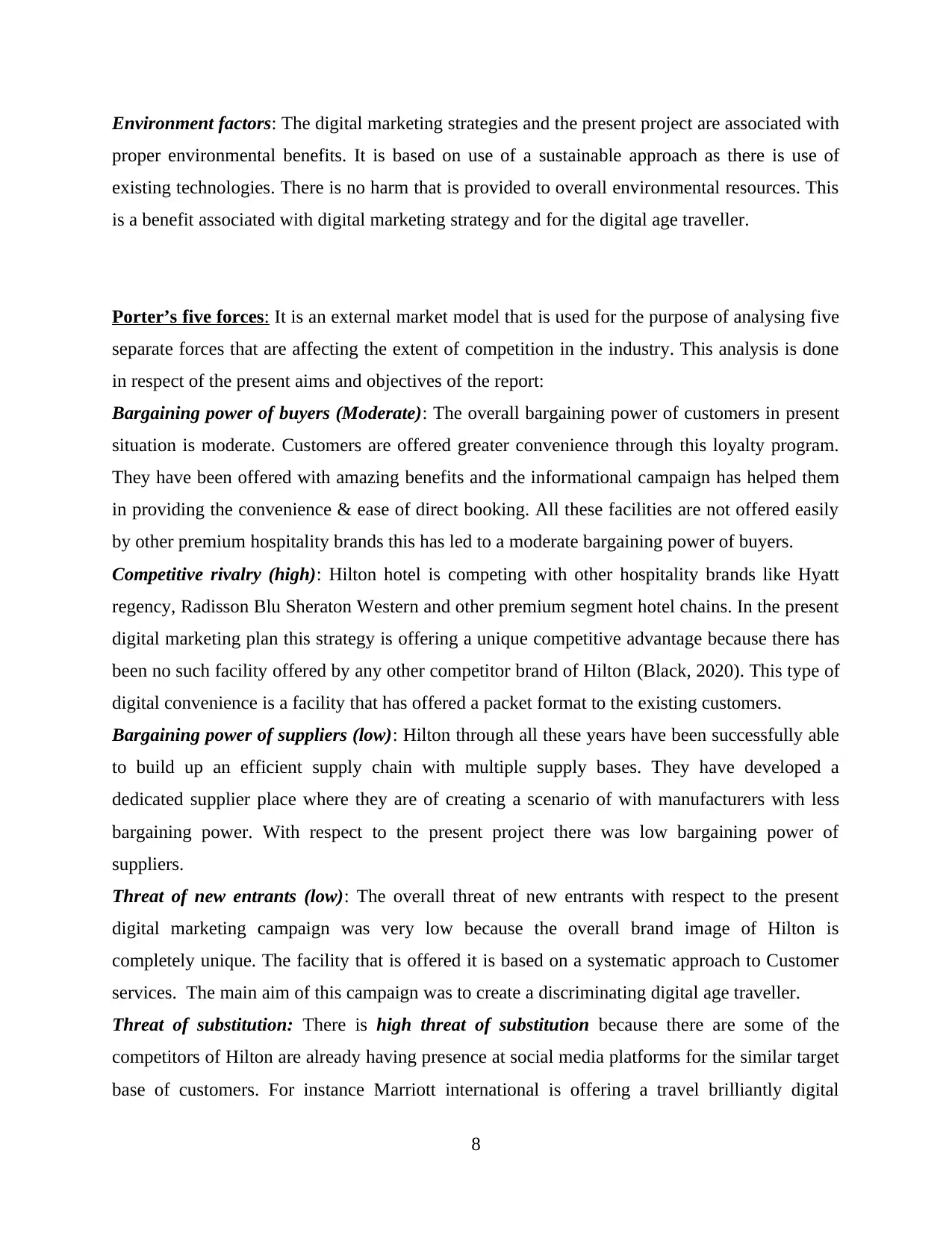
Environment factors: The digital marketing strategies and the present project are associated with
proper environmental benefits. It is based on use of a sustainable approach as there is use of
existing technologies. There is no harm that is provided to overall environmental resources. This
is a benefit associated with digital marketing strategy and for the digital age traveller.
Porter’s five forces: It is an external market model that is used for the purpose of analysing five
separate forces that are affecting the extent of competition in the industry. This analysis is done
in respect of the present aims and objectives of the report:
Bargaining power of buyers (Moderate): The overall bargaining power of customers in present
situation is moderate. Customers are offered greater convenience through this loyalty program.
They have been offered with amazing benefits and the informational campaign has helped them
in providing the convenience & ease of direct booking. All these facilities are not offered easily
by other premium hospitality brands this has led to a moderate bargaining power of buyers.
Competitive rivalry (high): Hilton hotel is competing with other hospitality brands like Hyatt
regency, Radisson Blu Sheraton Western and other premium segment hotel chains. In the present
digital marketing plan this strategy is offering a unique competitive advantage because there has
been no such facility offered by any other competitor brand of Hilton (Black, 2020). This type of
digital convenience is a facility that has offered a packet format to the existing customers.
Bargaining power of suppliers (low): Hilton through all these years have been successfully able
to build up an efficient supply chain with multiple supply bases. They have developed a
dedicated supplier place where they are of creating a scenario of with manufacturers with less
bargaining power. With respect to the present project there was low bargaining power of
suppliers.
Threat of new entrants (low): The overall threat of new entrants with respect to the present
digital marketing campaign was very low because the overall brand image of Hilton is
completely unique. The facility that is offered it is based on a systematic approach to Customer
services. The main aim of this campaign was to create a discriminating digital age traveller.
Threat of substitution: There is high threat of substitution because there are some of the
competitors of Hilton are already having presence at social media platforms for the similar target
base of customers. For instance Marriott international is offering a travel brilliantly digital
8
proper environmental benefits. It is based on use of a sustainable approach as there is use of
existing technologies. There is no harm that is provided to overall environmental resources. This
is a benefit associated with digital marketing strategy and for the digital age traveller.
Porter’s five forces: It is an external market model that is used for the purpose of analysing five
separate forces that are affecting the extent of competition in the industry. This analysis is done
in respect of the present aims and objectives of the report:
Bargaining power of buyers (Moderate): The overall bargaining power of customers in present
situation is moderate. Customers are offered greater convenience through this loyalty program.
They have been offered with amazing benefits and the informational campaign has helped them
in providing the convenience & ease of direct booking. All these facilities are not offered easily
by other premium hospitality brands this has led to a moderate bargaining power of buyers.
Competitive rivalry (high): Hilton hotel is competing with other hospitality brands like Hyatt
regency, Radisson Blu Sheraton Western and other premium segment hotel chains. In the present
digital marketing plan this strategy is offering a unique competitive advantage because there has
been no such facility offered by any other competitor brand of Hilton (Black, 2020). This type of
digital convenience is a facility that has offered a packet format to the existing customers.
Bargaining power of suppliers (low): Hilton through all these years have been successfully able
to build up an efficient supply chain with multiple supply bases. They have developed a
dedicated supplier place where they are of creating a scenario of with manufacturers with less
bargaining power. With respect to the present project there was low bargaining power of
suppliers.
Threat of new entrants (low): The overall threat of new entrants with respect to the present
digital marketing campaign was very low because the overall brand image of Hilton is
completely unique. The facility that is offered it is based on a systematic approach to Customer
services. The main aim of this campaign was to create a discriminating digital age traveller.
Threat of substitution: There is high threat of substitution because there are some of the
competitors of Hilton are already having presence at social media platforms for the similar target
base of customers. For instance Marriott international is offering a travel brilliantly digital
8
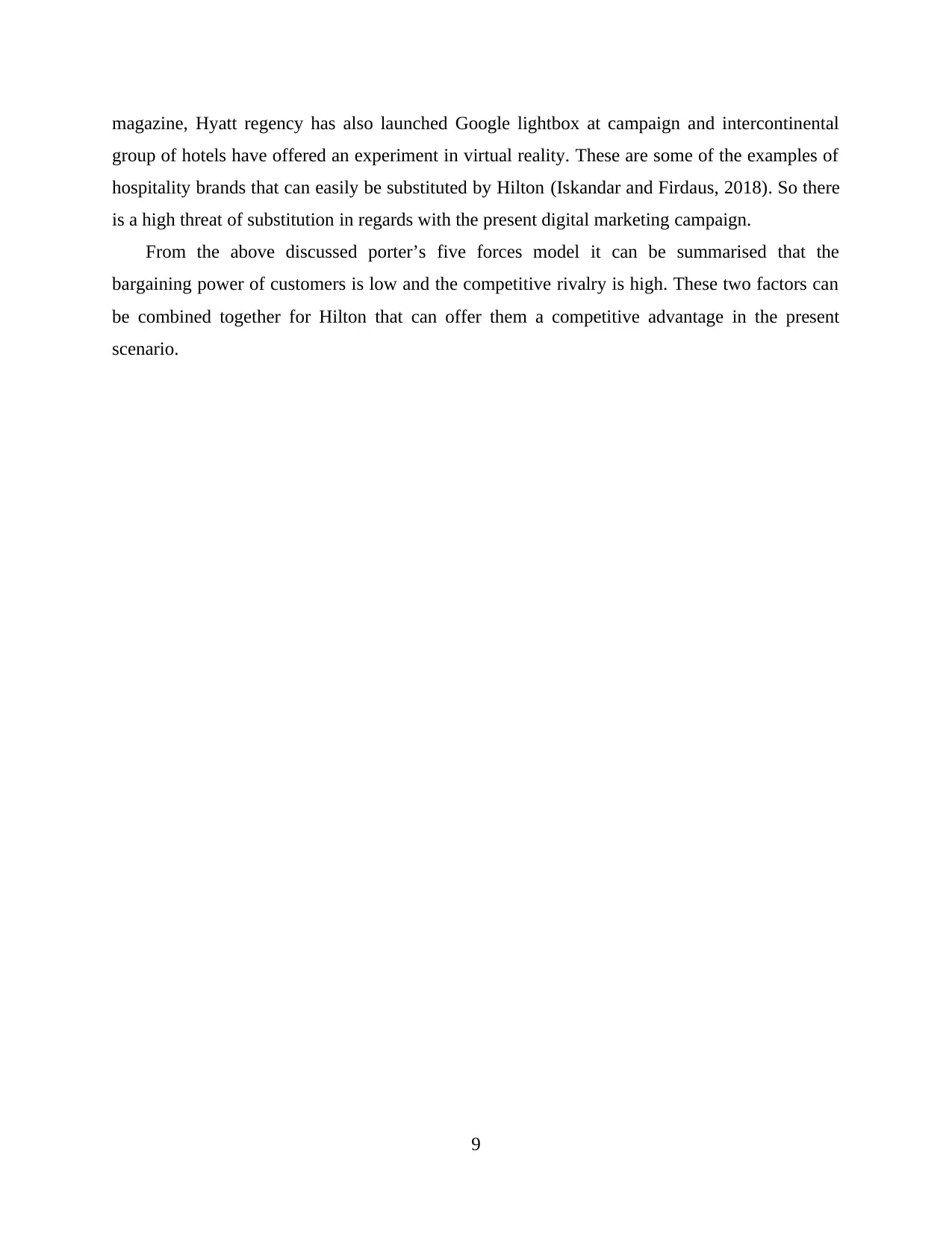
magazine, Hyatt regency has also launched Google lightbox at campaign and intercontinental
group of hotels have offered an experiment in virtual reality. These are some of the examples of
hospitality brands that can easily be substituted by Hilton (Iskandar and Firdaus, 2018). So there
is a high threat of substitution in regards with the present digital marketing campaign.
From the above discussed porter’s five forces model it can be summarised that the
bargaining power of customers is low and the competitive rivalry is high. These two factors can
be combined together for Hilton that can offer them a competitive advantage in the present
scenario.
9
group of hotels have offered an experiment in virtual reality. These are some of the examples of
hospitality brands that can easily be substituted by Hilton (Iskandar and Firdaus, 2018). So there
is a high threat of substitution in regards with the present digital marketing campaign.
From the above discussed porter’s five forces model it can be summarised that the
bargaining power of customers is low and the competitive rivalry is high. These two factors can
be combined together for Hilton that can offer them a competitive advantage in the present
scenario.
9
⊘ This is a preview!⊘
Do you want full access?
Subscribe today to unlock all pages.

Trusted by 1+ million students worldwide
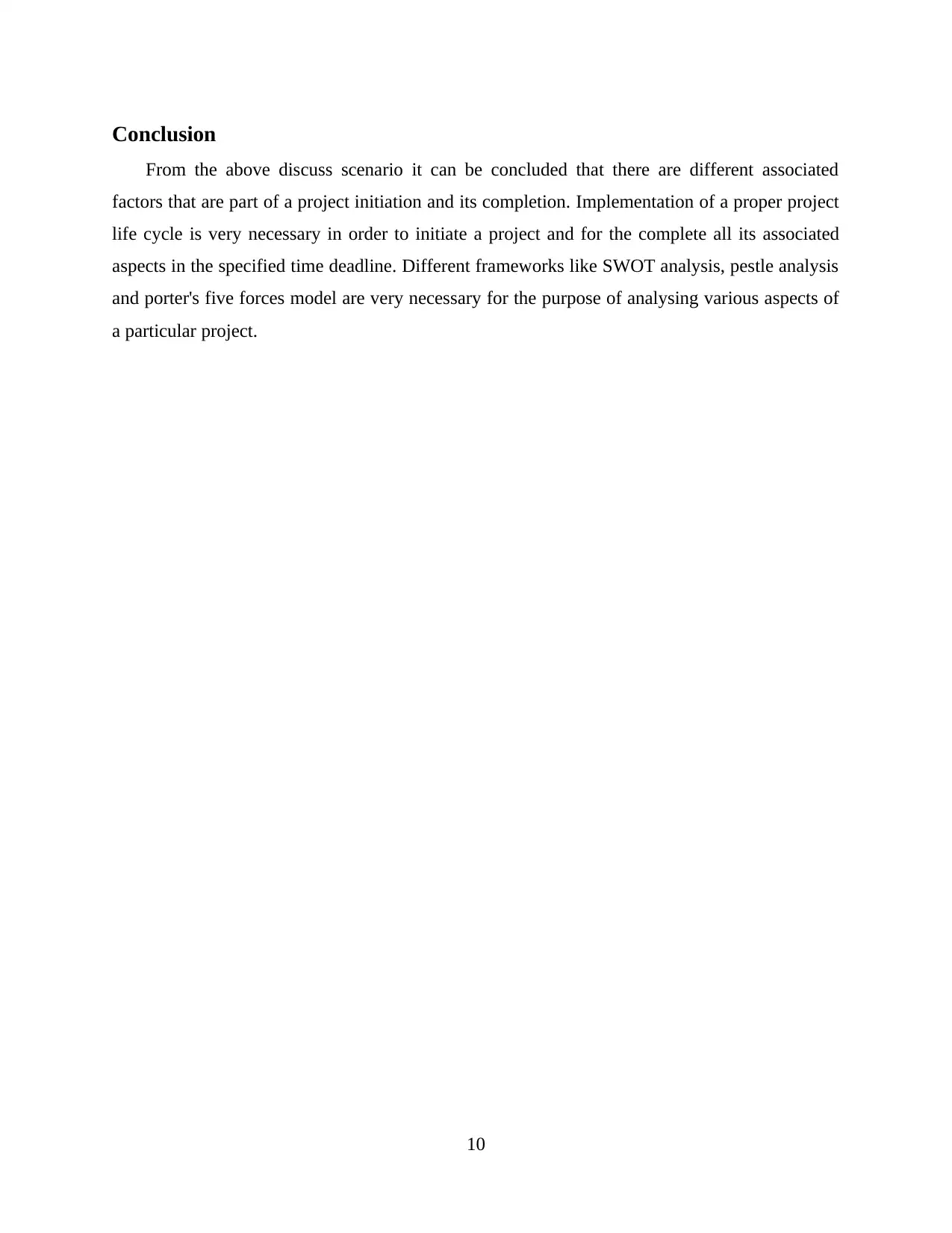
Conclusion
From the above discuss scenario it can be concluded that there are different associated
factors that are part of a project initiation and its completion. Implementation of a proper project
life cycle is very necessary in order to initiate a project and for the complete all its associated
aspects in the specified time deadline. Different frameworks like SWOT analysis, pestle analysis
and porter's five forces model are very necessary for the purpose of analysing various aspects of
a particular project.
10
From the above discuss scenario it can be concluded that there are different associated
factors that are part of a project initiation and its completion. Implementation of a proper project
life cycle is very necessary in order to initiate a project and for the complete all its associated
aspects in the specified time deadline. Different frameworks like SWOT analysis, pestle analysis
and porter's five forces model are very necessary for the purpose of analysing various aspects of
a particular project.
10
Paraphrase This Document
Need a fresh take? Get an instant paraphrase of this document with our AI Paraphraser
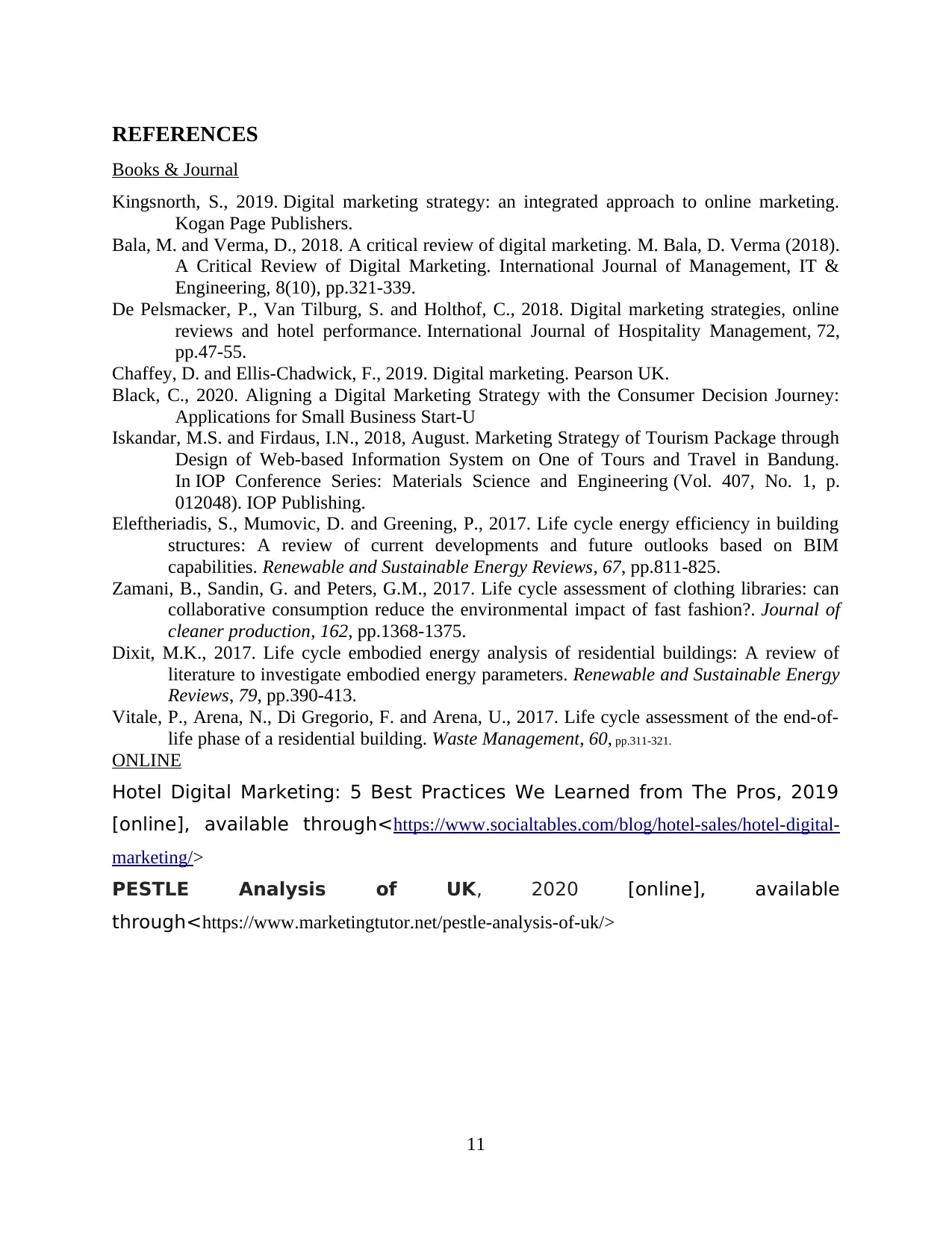
REFERENCES
Books & Journal
Kingsnorth, S., 2019. Digital marketing strategy: an integrated approach to online marketing.
Kogan Page Publishers.
Bala, M. and Verma, D., 2018. A critical review of digital marketing. M. Bala, D. Verma (2018).
A Critical Review of Digital Marketing. International Journal of Management, IT &
Engineering, 8(10), pp.321-339.
De Pelsmacker, P., Van Tilburg, S. and Holthof, C., 2018. Digital marketing strategies, online
reviews and hotel performance. International Journal of Hospitality Management, 72,
pp.47-55.
Chaffey, D. and Ellis-Chadwick, F., 2019. Digital marketing. Pearson UK.
Black, C., 2020. Aligning a Digital Marketing Strategy with the Consumer Decision Journey:
Applications for Small Business Start-U
Iskandar, M.S. and Firdaus, I.N., 2018, August. Marketing Strategy of Tourism Package through
Design of Web-based Information System on One of Tours and Travel in Bandung.
In IOP Conference Series: Materials Science and Engineering (Vol. 407, No. 1, p.
012048). IOP Publishing.
Eleftheriadis, S., Mumovic, D. and Greening, P., 2017. Life cycle energy efficiency in building
structures: A review of current developments and future outlooks based on BIM
capabilities. Renewable and Sustainable Energy Reviews, 67, pp.811-825.
Zamani, B., Sandin, G. and Peters, G.M., 2017. Life cycle assessment of clothing libraries: can
collaborative consumption reduce the environmental impact of fast fashion?. Journal of
cleaner production, 162, pp.1368-1375.
Dixit, M.K., 2017. Life cycle embodied energy analysis of residential buildings: A review of
literature to investigate embodied energy parameters. Renewable and Sustainable Energy
Reviews, 79, pp.390-413.
Vitale, P., Arena, N., Di Gregorio, F. and Arena, U., 2017. Life cycle assessment of the end-of-
life phase of a residential building. Waste Management, 60, pp.311-321.
ONLINE
Hotel Digital Marketing: 5 Best Practices We Learned from The Pros, 2019
[online], available through<https://www.socialtables.com/blog/hotel-sales/hotel-digital-
marketing/>
PESTLE Analysis of UK, 2020 [online], available
through<https://www.marketingtutor.net/pestle-analysis-of-uk/>
11
Books & Journal
Kingsnorth, S., 2019. Digital marketing strategy: an integrated approach to online marketing.
Kogan Page Publishers.
Bala, M. and Verma, D., 2018. A critical review of digital marketing. M. Bala, D. Verma (2018).
A Critical Review of Digital Marketing. International Journal of Management, IT &
Engineering, 8(10), pp.321-339.
De Pelsmacker, P., Van Tilburg, S. and Holthof, C., 2018. Digital marketing strategies, online
reviews and hotel performance. International Journal of Hospitality Management, 72,
pp.47-55.
Chaffey, D. and Ellis-Chadwick, F., 2019. Digital marketing. Pearson UK.
Black, C., 2020. Aligning a Digital Marketing Strategy with the Consumer Decision Journey:
Applications for Small Business Start-U
Iskandar, M.S. and Firdaus, I.N., 2018, August. Marketing Strategy of Tourism Package through
Design of Web-based Information System on One of Tours and Travel in Bandung.
In IOP Conference Series: Materials Science and Engineering (Vol. 407, No. 1, p.
012048). IOP Publishing.
Eleftheriadis, S., Mumovic, D. and Greening, P., 2017. Life cycle energy efficiency in building
structures: A review of current developments and future outlooks based on BIM
capabilities. Renewable and Sustainable Energy Reviews, 67, pp.811-825.
Zamani, B., Sandin, G. and Peters, G.M., 2017. Life cycle assessment of clothing libraries: can
collaborative consumption reduce the environmental impact of fast fashion?. Journal of
cleaner production, 162, pp.1368-1375.
Dixit, M.K., 2017. Life cycle embodied energy analysis of residential buildings: A review of
literature to investigate embodied energy parameters. Renewable and Sustainable Energy
Reviews, 79, pp.390-413.
Vitale, P., Arena, N., Di Gregorio, F. and Arena, U., 2017. Life cycle assessment of the end-of-
life phase of a residential building. Waste Management, 60, pp.311-321.
ONLINE
Hotel Digital Marketing: 5 Best Practices We Learned from The Pros, 2019
[online], available through<https://www.socialtables.com/blog/hotel-sales/hotel-digital-
marketing/>
PESTLE Analysis of UK, 2020 [online], available
through<https://www.marketingtutor.net/pestle-analysis-of-uk/>
11

12
⊘ This is a preview!⊘
Do you want full access?
Subscribe today to unlock all pages.

Trusted by 1+ million students worldwide
1 out of 12
Related Documents
Your All-in-One AI-Powered Toolkit for Academic Success.
+13062052269
info@desklib.com
Available 24*7 on WhatsApp / Email
![[object Object]](/_next/static/media/star-bottom.7253800d.svg)
Unlock your academic potential
Copyright © 2020–2025 A2Z Services. All Rights Reserved. Developed and managed by ZUCOL.



